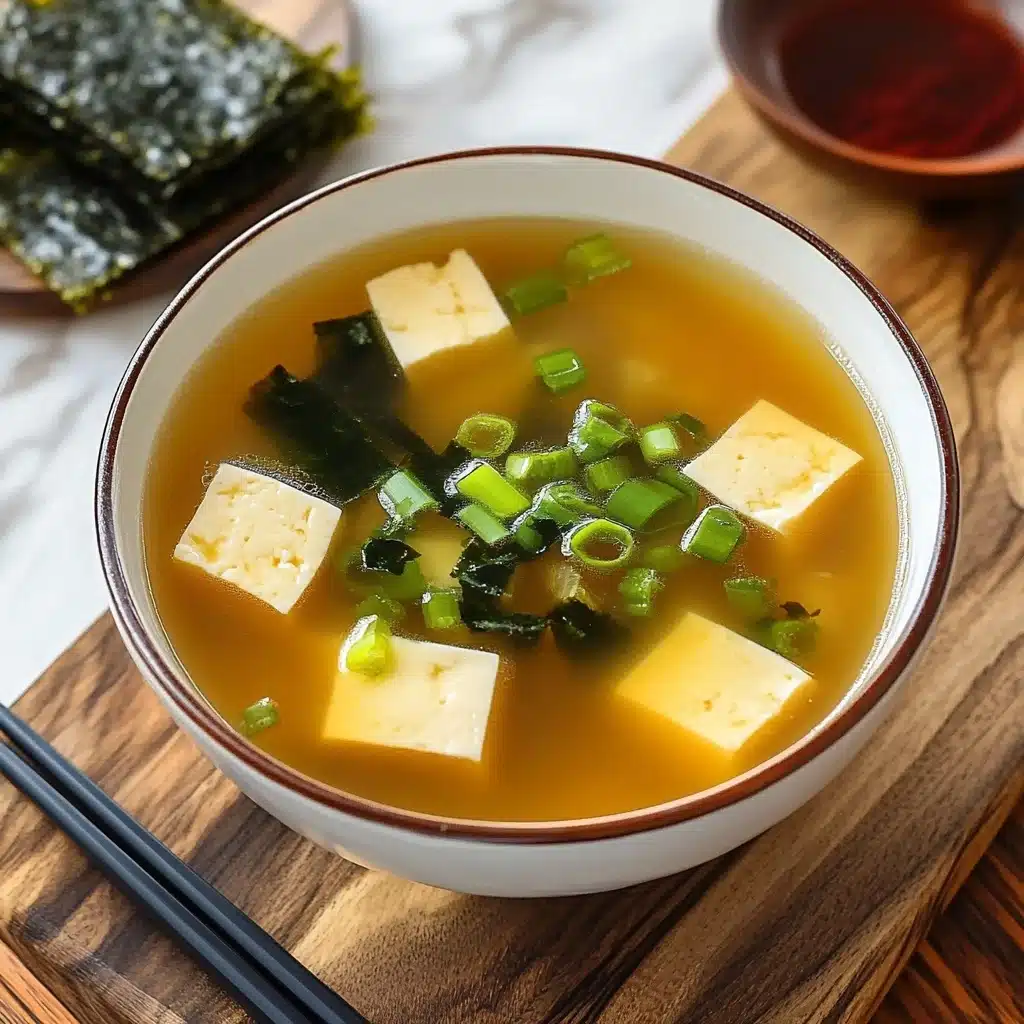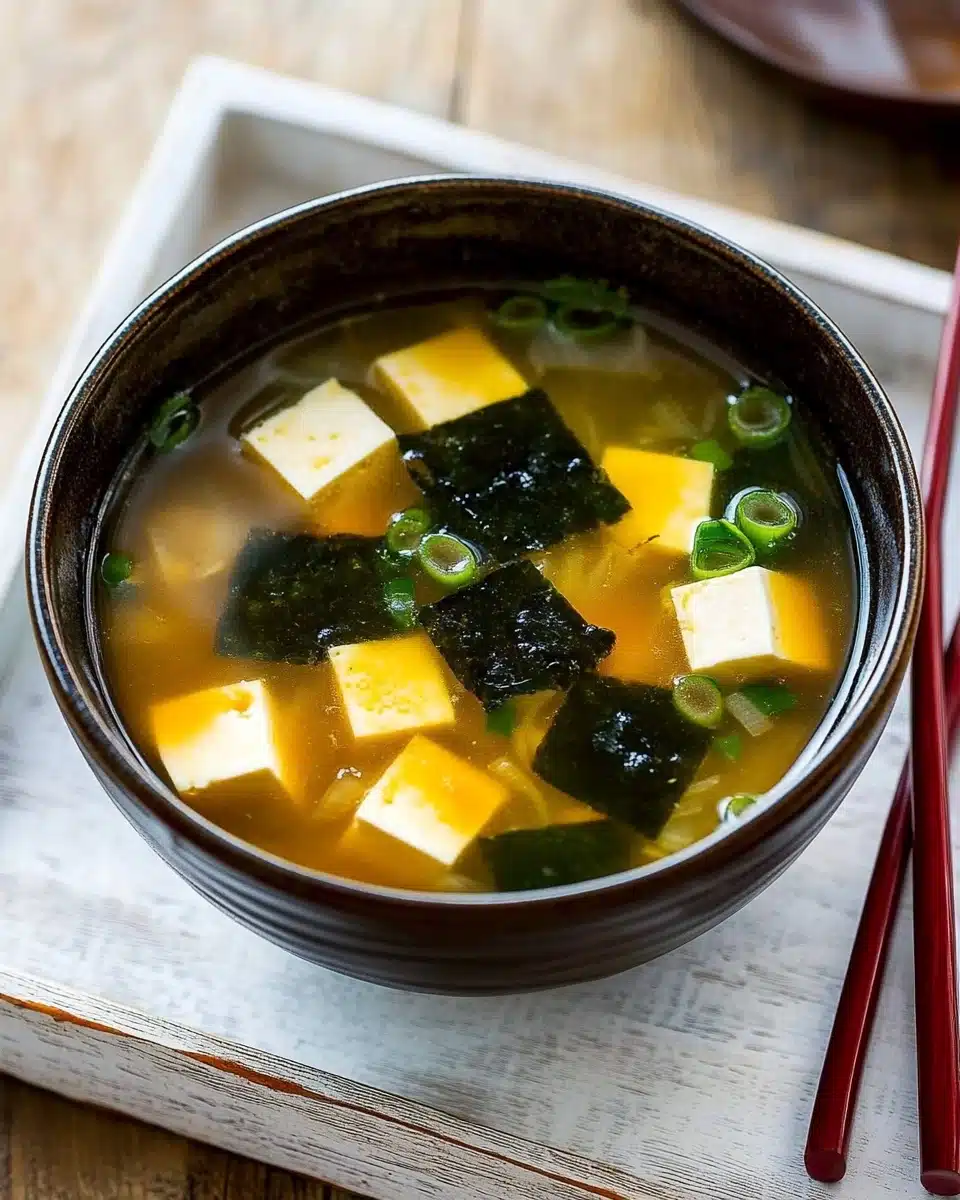There’s something truly comforting about a steaming bowl of Homemade Miso Soup with Tofu: it’s nourishing, flavorful, and wonderfully simple to make from scratch. Whether you’re looking to replicate your favorite Japanese restaurant starter or want a wholesome, soothing soup for chilly evenings, this classic miso soup brings together silky tofu, umami-rich dashi, and a delicate balance of seaweed and scallions to warm you from the inside out.
Why You’ll Love This Recipe
- Restaurant-Quality Flavor at Home: Homemade Miso Soup with Tofu tastes just like the kind you find in authentic Japanese eateries, thanks to real dashi and high-quality miso.
- Quick and Effortless: You can make this soup from scratch in around 20 minutes, making it a perfect meal starter or a light lunch even on your busiest days.
- Healthy and Nourishing: With its plant-based proteins, minerals, and probiotics, this miso soup is a wholesome way to warm up and fuel your body.
- Easily Customizable: Switch up the ingredients to suit a vegan diet, add seasonal veggies, or tailor the flavor to your taste—Homemade Miso Soup with Tofu is endlessly adaptable!

Ingredients You’ll Need
You don’t need fancy ingredients to create a delicious bowl of Homemade Miso Soup with Tofu—just a few Japanese staples that, together, create an amazing depth of flavor. Each ingredient brings a unique contribution, and you’ll see just how quickly these simple elements come together for restaurant-worthy soup.
- Kombu (dried kelp): This sea vegetable is rich in umami and forms the savory backbone of your dashi broth. Don’t wash off the white stuff—it’s packed with flavor!
- Katsuobushi (dried bonito flakes): These smoky, savory flakes deepen the broth’s body; if you’re vegan or vegetarian, you can easily omit them or substitute with dried shiitake mushrooms.
- Miso paste: Salty, mellow, and beautifully fermented, miso is the soul of the soup. White, yellow, or red are all great—taste as you go!
- Silken or soft tofu: This delicate tofu adds protein and a gentle, creamy texture that pairs perfectly with the soup’s broth.
- Dried wakame seaweed: Wakame rehydrates in the broth to infuse mild, briny notes and a delightful, slippery texture.
- Green onion/scallion: Sliced thin, this adds a fresh, snappy finish that balances rich miso flavors.
- Water: It’s the base of your dashi—filtered water gives the cleanest flavor.
Variations
Homemade Miso Soup with Tofu is fun to play around with—while the core recipe is classic, you can stir in extra ingredients, swap out components, or make it entirely plant-based without breaking a sweat. Try these adaptation ideas and make each batch your own!
- Vegan Miso Soup: Simply skip the bonito flakes and use kombu or kombu plus dried shiitake mushrooms for your dashi—just as delicious and totally plant-based.
- Extra Veggie Boost: Add thinly sliced mushrooms, spinach, or even shredded carrots for added color and nutrients without losing that cozy miso vibe.
- Different Tofu Textures: Swap silken tofu for firmer varieties if you prefer a heartier bite in your bowl.
- Spicy Miso Soup: Mix in a hint of chili oil, spicy miso, or a sprinkle of shichimi togarashi for a warming kick!
How to Make Homemade Miso Soup with Tofu
Step 1: Prepare the Dashi Broth
Begin by adding kombu and water to a medium saucepan. For the deepest flavor, let the kombu soak for about 30 minutes if you have the time. Then, gently bring the pot to a near-simmer over medium-low heat—don’t rush this part! Right before the water boils, remove the kombu so your dashi remains clean and sweet without any bitterness.
Step 2: Add Katsuobushi (or Make Vegan Dashi)
If you’re making classic dashi, gently add your katsuobushi (bonito flakes) to the hot water and bring just to a boil. Let it simmer for about 30 seconds, then turn off the heat and allow it to sit for 10 minutes so all the flavor infuses the broth. For vegan dashi, skip the bonito and you’re good to go!
Step 3: Strain and Reserve the Dashi
Pour the broth through a fine-mesh sieve to remove the katsuobushi, pressing gently if needed. You’ll be left with about 4 cups of beautiful, golden dashi that forms the delicious base of your Homemade Miso Soup with Tofu.
Step 4: Prep Your Ingredients
While your dashi is cooling slightly, slice the green onion into thin rounds and cut the silken tofu into neat ½-inch cubes. Handling soft tofu gently is key—try to cut it on a cutting board for perfect little squares that won’t crumble in the pot.
Step 5: Dissolve the Miso Paste
Return the strained dashi to your saucepan. Scoop the miso paste into a ladle and gradually mix some hot dashi into it, stirring with chopsticks or a small whisk until smooth. Then, stir the dissolved miso back into the pot so there are no lumps and all that umami flavor disperses evenly—never boil after adding miso!
Step 6: Add Tofu, Wakame, and Green Onion
Slip the tofu cubes into the miso soup, followed by dried wakame (which blooms almost instantly in the hot broth) and your fresh green onions. Give everything a gentle swirl, and your Homemade Miso Soup with Tofu is officially ready to serve!
Pro Tips for Making Homemade Miso Soup with Tofu
- Gentle Heat, Greater Flavor: Always dissolve miso paste off the heat—boiling the soup after miso goes in will kill its delicate aroma and beneficial probiotics.
- Silken Tofu Handling: For ultra-smooth cubes, cut the tofu just before adding and slide it gently into the soup to prevent breakage.
- Rehydrate Wakame Separately (if Salty): If you’re watching your sodium, soak wakame in plain water and drain before adding so the soup doesn’t pick up too much salt.
- Dashi Storage Magic: Make a big batch of dashi ahead and keep it on hand—refrigerate for quick miso soup anytime cravings strike!
How to Serve Homemade Miso Soup with Tofu

Garnishes
A handful of freshly sliced scallions is always a classic, but you can sprinkle in toasted sesame seeds, a dash of shichimi togarashi, or even a few teeny pieces of yuzu zest for unexpected brightness. The toppings give each bowl of Homemade Miso Soup with Tofu a spark of color and fragrance that makes every spoonful special.
Side Dishes
Pair your miso soup with a bowl of fluffy steamed rice, simple cucumber sunomono (vinegared salad), or crisp veggie tempura for a balanced Japanese meal. It’s also a perfect start to a sushi dinner—nothing feels quite as cozy as sipping Homemade Miso Soup with Tofu alongside family and friends.
Creative Ways to Present
Ladle the soup into beautiful lacquered bowls for an authentic touch, or use clear glass cups to show off those pretty swirls of green, white, and seaweed. Little miso soup bowls with lids keep everything toasty—lift the lid and release the fragrant cloud of steam for a moment of dinnertime theater!
Make Ahead and Storage
Storing Leftovers
If you find yourself with extra Homemade Miso Soup with Tofu, let it cool to room temperature, then refrigerate in an airtight container for up to two days. The aroma does fade a little, so it’s best enjoyed fresh, but leftovers still make a speedy, soul-soothing lunch.
Freezing
You can freeze the dashi broth for up to two weeks, but tofu changes texture after freezing—so remove it before freezing and add fresh tofu once you reheat the soup for the best experience.
Reheating
Gently heat your miso soup over medium (never boiling!) just until hot. Boiling destroys the nuances of miso, so go slow, and add a little fresh miso as needed to revive flavor before enjoying again.
FAQs
-
Can I use a dashi powder instead of making it from scratch?
Absolutely! Dashi powder or packets are a great shortcut for Homemade Miso Soup with Tofu on busy nights. While homemade dashi has a more delicate, layered flavor, instant dashi still creates an excellent, flavorful broth in just minutes.
-
Does it matter what type of miso paste I use?
Any miso will work, but the flavor varies: white miso is mild and sweet, red miso brings deep, savory notes, and mixed (awase) miso offers balance. Try different kinds until you discover your favorite in Homemade Miso Soup with Tofu!
-
Can I add other vegetables or proteins?
Definitely! Mushrooms, spinach, carrots, or even a handful of baby bok choy are delicious additions, and you can experiment with edamame, shrimp, or chicken for a heartier soup while keeping the spirit of Homemade Miso Soup with Tofu.
-
Why shouldn’t I boil the soup after adding miso paste?
Boiling destroys miso’s delicate aroma, flavor, and live enzymes. For the most nourishing and tasty bowl of Homemade Miso Soup with Tofu, always stir in miso off the heat and serve as soon as possible.
Final Thoughts
Once you try making Homemade Miso Soup with Tofu from scratch, you’ll never look back—the fresh aroma, customizable flavors, and silky tofu make every bowl taste like a small act of self-care. Give it a try on your next cozy night in, and let this humble soup become a favorite in your kitchen too!
Print
Homemade Miso Soup with Tofu Recipe
- Prep Time: 5 minutes
- Cook Time: 15 minutes
- Total Time: 20 minutes
- Yield: 4 servings
- Category: Soup
- Method: Boiling, Simmering
- Cuisine: Japanese
- Diet: Vegetarian
Description
Learn how to make delicious Homemade Miso Soup with Tofu, a traditional Japanese favorite that’s comforting and flavorful. This recipe includes making your own dashi broth from scratch and assembling the miso soup with tofu, wakame seaweed, and green onions.
Ingredients
For the Dashi (makes a scant 4 cups)
- 4 cups water
- 1 piece kombu (dried kelp) (1/3 oz, 10 g per piece; 4 x 4 inches or 10 x 10 cm)
- 1 cup katsuobushi (dried bonito flakes) (packed; I used a loosely packed 3 cups in the video for stronger flavor)
For the Miso Soup
- 7 oz soft/silken tofu (kinugoshi dofu)
- 4 Tbsp miso (use 1 Tbsp, 18 g for every 1 cup, 240 ml of dashi)
- 1 Tbsp dried wakame seaweed
- 1 green onion/scallion
Instructions
- Dashi 3 Ways
Gather all the ingredients.
- Miso Soup Ingredients
Cut 1 green onion/scallion into thin rounds.
- To Make the Dashi (can make in advance)
Add 4 cups water and 1 piece kombu (dried kelp) to a medium saucepan. If you have time, soak the kombu in water for 30 minutes. NEVER wash kombu and do not remove the white substance—that’s umami! These days, it‘s pretty clean, so just make sure there are no dirt particles.
- …
Notes
- If you accidentally add too much miso, dilute the miso soup with dashi (or water).
- It is very common to cut tofu on your palm in Japan. However, I recommend using a cutting board if you have never done this.
- Never boil miso soup because it loses flavor and aroma.
Nutrition
- Serving Size: 1 serving
- Calories: 57 kcal
- Sugar: 2 g
- Sodium: 532 mg
- Fat: 2 g
- Saturated Fat: 0.3 g
- Unsaturated Fat: 1 g
- Trans Fat: 0 g
- Carbohydrates: 5 g
- Fiber: 1 g
- Protein: 4 g
- Cholesterol: 0 mg








